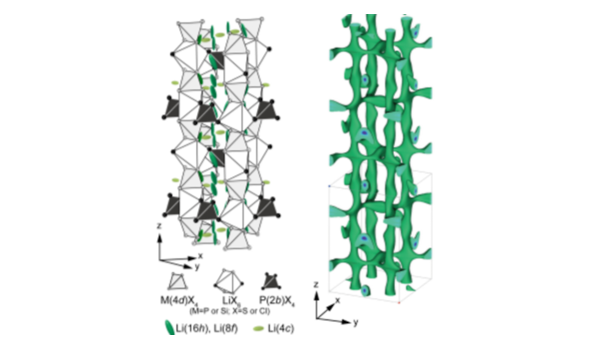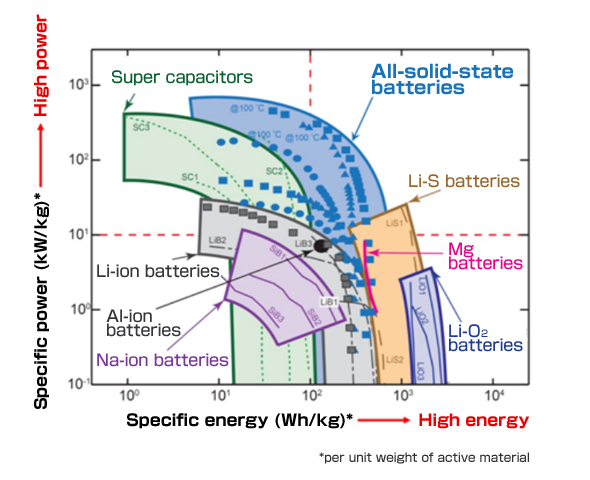 Catalysts and batteries
Development of All-Solid-State Ceramic Batteries with Solid Electrolytes
Toward the Realization of Next-Generation Batteries Superior to Existing Li-ion Batteries
Catalysts and batteries
Development of All-Solid-State Ceramic Batteries with Solid Electrolytes
Toward the Realization of Next-Generation Batteries Superior to Existing Li-ion Batteries
- Observation

-

- Experiment

-

- Discovered solid electrolytes possessing higher lithium-based ionic conductivity than conventional electrolytes
- Developed an all-solid-state battery having at least 3 times more power than Li-ion batteries
- Elucidated three-dimensional ionic conduction pathways in solid electrolytes using neutron diffraction analysis
Electrolytes hold the key to the development of next-generation batteries
The development of next-generation batteries with better performance than current lithium-ion batteries from the perspectives of capacity, cost, and safety will be crucial for electric vehicles, plug-in hybrids, and smart grids (next-generation transmission and distribution networks) to permeate society. The key to this development lies in a single constituent material of batteries called “electrolytes.”
While today’s Li-ion batteries employ organic liquid electrolytes, we are using solid electrolytes in an effort to develop all-solid-state batteries whose materials, including the cathode and anode, are wholly solid. The use of solid electrolytes can lead to concepts that upend existing conventions for battery pack design, such as bipolar laminated structures that cannot be formed in conventional electrolyte systems, and is expected to produce batteries with higher capacity and higher power. Moreover, electrolytes in a solid state improve battery safety.
All-solid-state batteries possessing more than 3 times the power of conventional Li-ion batteries
We discovered Li10GeP2S12, a material possessing ionic conductivity that rivals organic electrolytes. Thereafter, we also found Li9.54Si1.74P1.44S11.7Cl0.3 possessing the highest ionic conductivity, Li9.6P3S122 that has a large electrochemical window and can be used as electrolyte for lithium-metal anodes, and the SnSi-based material Li10+δ[SnySi1-y]1+δP2-δS12 that is less expensive and easy to synthesize.
Using these electrolytes, we manufactured all-solid-state ceramic batteries that are much-anticipated for their noncombustibility and safety aspects, and demonstrated their inherent potential for much faster charging and higher power than today’s Li-ion batteries. These all-solid-state batteries showed more than three times the power at room temperature than conventional Li-ion batteries and excellent charging/discharging properties at both low temperatures (-30℃) and high temperatures (100℃), which is a shortcoming of Li-ion batteries employing organic electrolytes.
Crystal structure analysis through neutron diffraction revealed that Li9.54Si1.74P1.44S11.7Cl0.3 possesses a three-dimensional framework structure (Figure 1) in which lithium forms a series of chain-like units and three-dimensional conduction pathways at room temperature, yielding high lithium-ion conductivity.
The all-solid state batteries developed in this study clearly possess power and energy characteristics that far exceed those of not only existing Li-ion batteries, but also the various batteries currently being developed as next-generation batteries (Figure 2).

Figure 1 3D framework structure of Li9.54Si1.74P1.44S11.7Cl0.3 and the distribution of Li at room temperature

Figure 2 Comparing specific power and energy for various electrochemical devices; all-solid state batteries combine the features of storage batteries with capacitors

Ryoji Kanno
School of Materials and Chemical Technology
Tokyo Institute of Technology
References
- [1] Kamaya, N. et al., Nat. Mater. 2011, 10 (9), 682-686.
- [2] Kato, Y., et al., Nature Energy 2016, 16030.
- [3] Sun Y., et al., Chemistry of Materials, 2017, 29(14), 5858-5864.